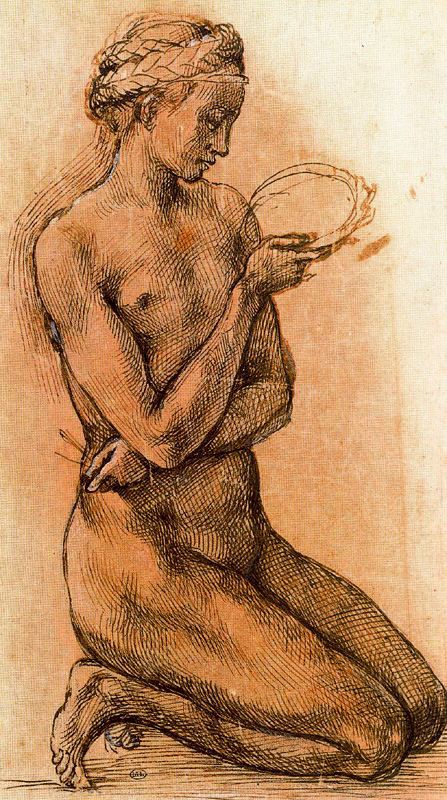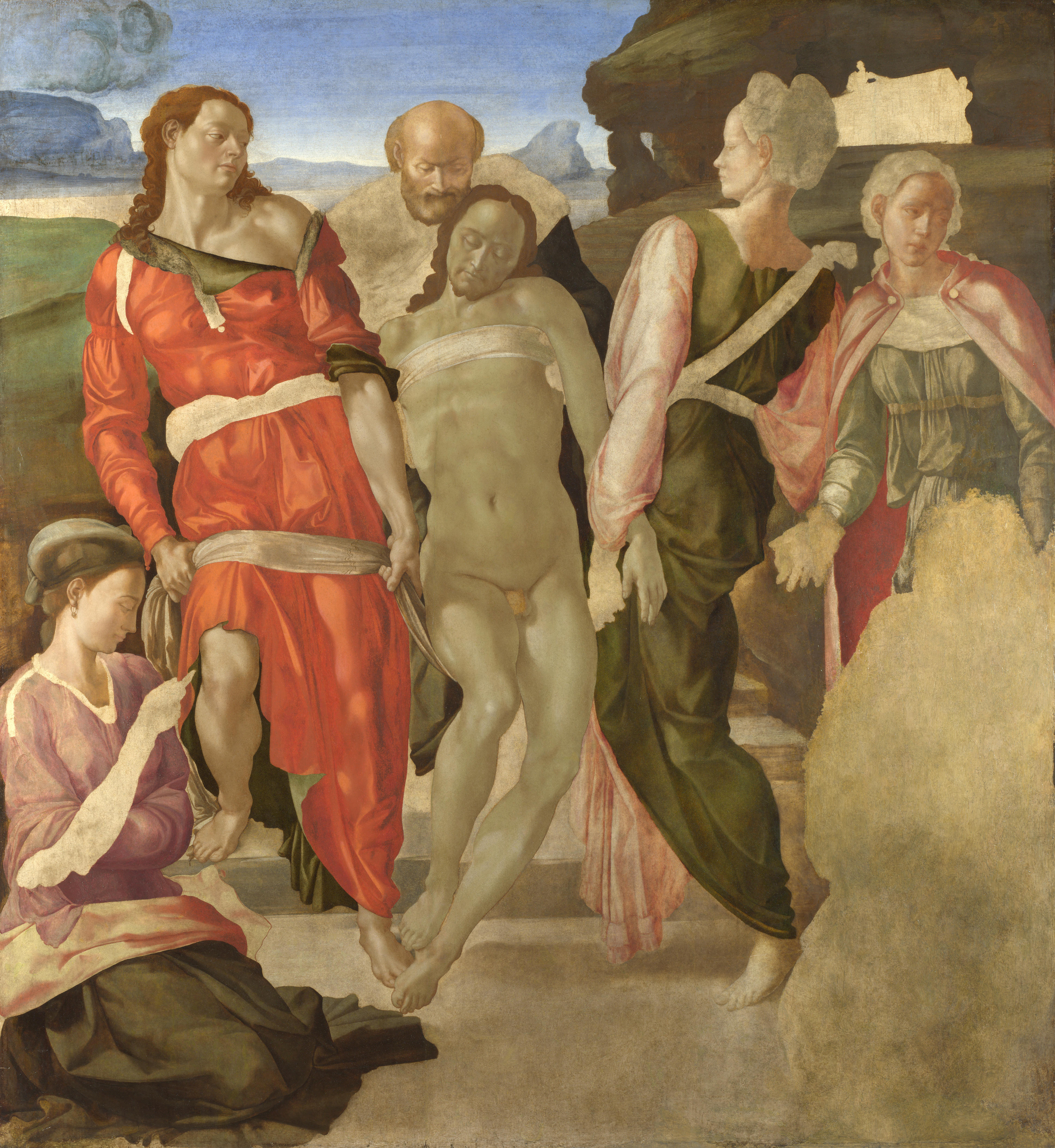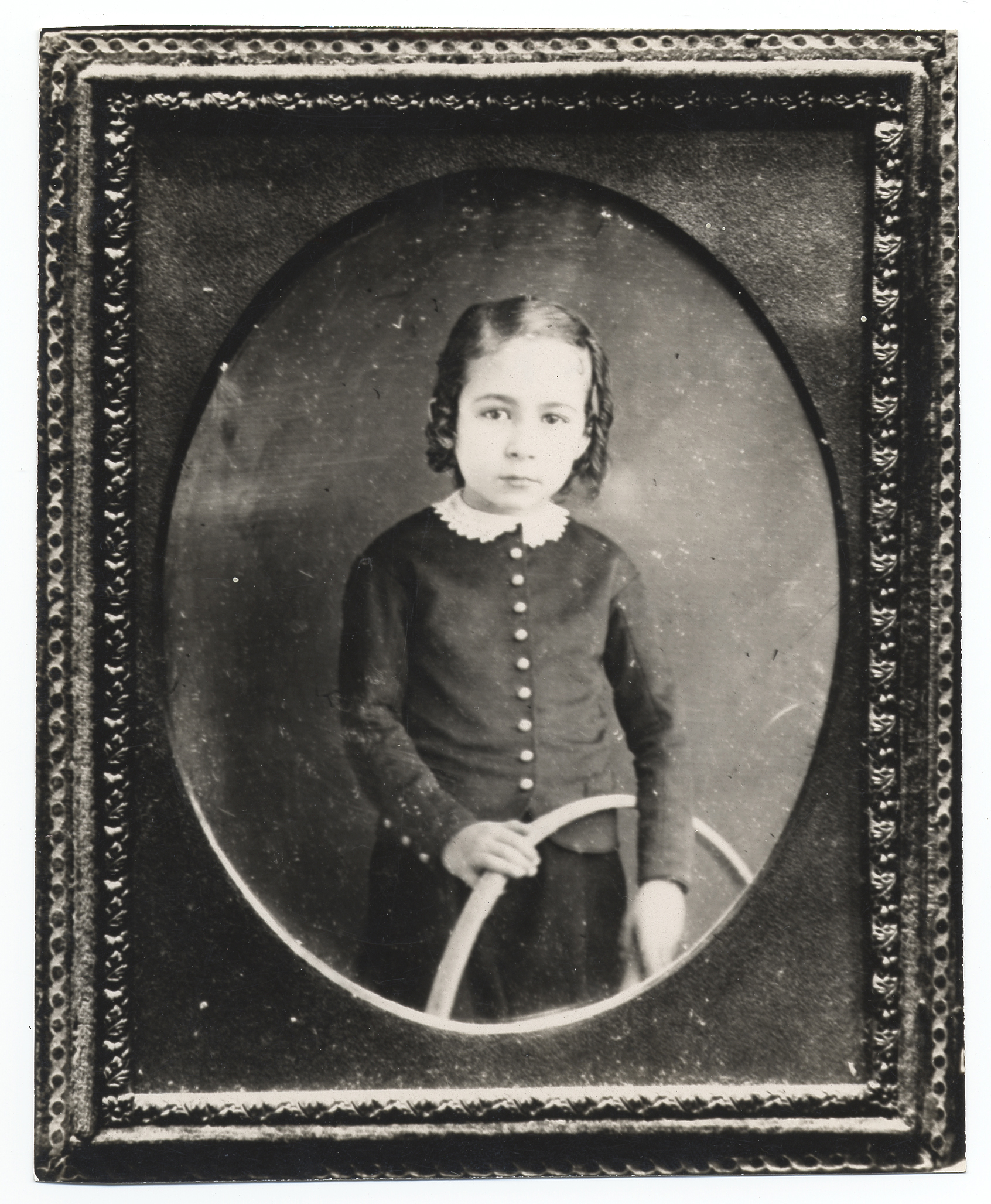|
Figure Study
A figure study is a drawing or painting of the human body made in preparation for a more composed or finished work; or to learn drawing and painting techniques in general and the human figure in particular. By preference, figure studies are done from a live model, but may also include the use of other references and the imagination of the artist. The live model may be clothed, or nude, but is usually nude for student work in order to learn human anatomy, or by professionals who establish the underlying anatomy before adding clothing in the final work. A related term in sculpture is a maquette, a small scale model or rough draft of a proposed work. Drawings may also be preparatory for sculptural work. Preparatory studies may be compositional, representing the entire proposed work, or may only be of certain details, such as hands and feet. Studies may be sketches completed in a relatively short length of time, or very detailed depending upon the artist's preferred methods. Drawings ... [...More Info...] [...Related Items...] OR: [Wikipedia] [Google] [Baidu] |
Study Of A Kneeling Nude Girl For The Entombment
''Study of a Kneeling Nude Girl for The Entombment'' is a drawing of c. 1500–1501 by Michelangelo, now in the Louvre Museum. It is in black chalk, with pen and ink and white highlighting, on pink prepared (coloured) paper, and measures 26.6 cm x 15.1 cm. It is a figure study made in preparation for his painting ''The Entombment'', and is Michelangelo's only surviving study that was probably drawn from a nude female model.Dunkerton, et al, 186 It also may be the earliest extant European drawing of a nude female model.Dunkerton, et al, 186 The figure in the drawing relates to a woman seated in the lower left foreground of the painting. Included in the study are narrative details such as the nails of the cross, held in her left hand, and the crown of thorns in her right. Although the drawing's attribution has been doubted, it is now accepted as authentic.Dunkerton, et al, 186Hirst, 63 The elaboration of the plaited hair suggests that the drawing was made from life using ... [...More Info...] [...Related Items...] OR: [Wikipedia] [Google] [Baidu] |
Henri De Toulouse-Lautrec
Comte Henri Marie Raymond de Toulouse-Lautrec-Monfa (24 November 1864 – 9 September 1901) was a French painter, printmaker, draughtsman, caricaturist and illustrator whose immersion in the colourful and theatrical life of Paris in the late 19th century allowed him to produce a collection of enticing, elegant, and provocative images of the sometimes decadent affairs of those times. Born into the aristocracy, Toulouse-Lautrec broke both his legs around the time of his adolescence and, due to the rare condition Pycnodysostosis, was very short as an adult due to his undersized legs. In addition to his alcoholism, he developed an affinity for brothels and prostitutes that directed the subject matter for many of his works recording many details of the late-19th-century bohemian lifestyle in Paris. Toulouse-Lautrec is among the painters described as being Post-Impressionists, with Paul Cézanne, Vincent van Gogh, Paul Gauguin, and Georges Seurat also commonly consider ... [...More Info...] [...Related Items...] OR: [Wikipedia] [Google] [Baidu] |
William Rush And His Model
''William Rush and His Model'' is the collective name given to several paintings by Thomas Eakins, one set from 1876–77 and the other from 1908. These works depict the American wood sculptor William Rush in 1808, carving his statue ''Water Nymph and Bittern'' for a fountain at Philadelphia's first waterworks. The water nymph is an allegorical figure representing the Schuylkill River, which provided the city's drinking water, and on her shoulder is a bittern, a native waterbird related to the heron. Hence, these Eakins works are also known as ''William Rush Carving His Allegorical Figure of the Schuylkill River''. ''Nymph and Bittern'' Philadelphia's first waterworks was located at Centre Square, now the site of Philadelphia City Hall. Steam engines drew drinking water from the Schuylkill River and pumped it up to tanks in the engine house tower, from which it was distributed by gravity through underground mains to the city. Rush, a carver of ship figureheads, was commissione ... [...More Info...] [...Related Items...] OR: [Wikipedia] [Google] [Baidu] |
Figure Drawing
A figure drawing is a drawing of the human form in any of its various shapes and postures using any of the drawing media. The term can also refer to the act of producing such a drawing. The degree of representation may range from highly detailed, anatomically correct renderings to loose and expressive sketches. A life drawing is a drawing of the human figure, traditionally nude, from observation of a live model. Creating life drawings, or life studies, in a life class, has been a large element in the traditional training of artists in the Western world since the Renaissance. A figure drawing may be a composed work of art or a figure study done in preparation for a more finished work such as a painting. Figure drawing is arguably the most difficult subject an artist commonly encounters, and entire courses are dedicated to the subject. The human figure is one of the most enduring themes in the visual arts, and the human figure can be the basis of portraiture, illustration, sculptu ... [...More Info...] [...Related Items...] OR: [Wikipedia] [Google] [Baidu] |
Figure Painting
A figure painting is a work of fine art in any of the Painting#Painting media, painting media with the primary subject being the human figure, whether clothed or Nude (art), nude. Figure painting may also refer to the activity of creating such a work. The human figure has been one of the constant subjects of art since the first stone age cave paintings, and has been reinterpreted in various styles throughout history. Unlike figure drawings which are usually nudes, figure paintings are often clothed depictions which may be either historically accurate or symbolic. Figure painting is not synonymous with figurative art, which may depict real objects of any kind (including humans and animals). Clothed figures Portraiture A portrait painting focuses on the creation of a likeness of a particular individual or group. Everyday life Genre painting portray ordinary people engaged in common activities. Narrative paintings Historical paintings depict events in a narrative, which ... [...More Info...] [...Related Items...] OR: [Wikipedia] [Google] [Baidu] |
Nude (art)
The nude, as a form of visual art that focuses on the unclothed human figure, is an enduring tradition in Western art. It was a preoccupation of Ancient Greek art, and after a semi-dormant period in the Middle Ages returned to a central position with the Renaissance. Unclothed figures often also play a part in other types of art, such as history painting, including allegorical and religious art, portraiture, or the decorative arts. From prehistory to the earliest civilizations, nude female figures are generally understood to be symbols of fertility or well-being. In India, the Khajuraho Group of Monuments built between 950 and 1050 CE are known for their erotic sculptures, which comprise about 10% of the temple decorations. Japanese prints are one of the few non-western traditions that can be called nudes, but the activity of communal bathing in Japan is portrayed as just another social activity, without the significance placed upon the lack of clothing that exists in the ... [...More Info...] [...Related Items...] OR: [Wikipedia] [Google] [Baidu] |
Herbert James Draper
Herbert James Draper ( (baptism record) – ) was an English Classicist painter whose career began in the Victorian era and extended through the first two decades of the 20th century. Life Born in London, the son of a fruit merchant named John James Draper and his wife Emma, he was educated at Bruce Castle School in Tottenham''The Times'', Thursday, Sep 23, 1920; pg. 1; Issue 42523; col A and then went on to study art at the Royal Academy. He undertook several educational trips to Rome and Paris between 1888 and 1892, having won the Royal Academy Gold Medal and Travelling Studentship in 1889. In the 1890s, he worked as an illustrator, eventually settling in London. In 1891, he married Ida (née Williams), with whom he had a daughter, Yvonne. He died of arteriosclerosis at the age of 56, in his home on Abbey Road. Career Draper's most productive period began in 1894. He focused mainly on mythological themes from ancient Greece. His painting ''The Lament for Icarus'' (1898) ... [...More Info...] [...Related Items...] OR: [Wikipedia] [Google] [Baidu] |
Thomas Eakins
Thomas Cowperthwait Eakins (; July 25, 1844 – June 25, 1916) was an American realist painter, photographer, sculptor, and fine arts educator. He is widely acknowledged to be one of the most important American artists. For the length of his professional career, from the early 1870s until his health began to fail some 40 years later, Eakins worked exactingly from life, choosing as his subject the people of his hometown of Philadelphia. He painted several hundred portraits, usually of friends, family members, or prominent people in the arts, sciences, medicine, and clergy. Taken ''en masse'', the portraits offer an overview of the intellectual life of contemporary Philadelphia; individually, they are incisive depictions of thinking persons. In addition, Eakins produced a number of large paintings that brought the portrait out of the drawing room and into the offices, streets, parks, rivers, arenas, and surgical amphitheaters of his city. These active outdoor venues allo ... [...More Info...] [...Related Items...] OR: [Wikipedia] [Google] [Baidu] |
Sistine Chapel Ceiling
The Sistine Chapel ceiling ( it, Soffitto della Cappella Sistina), painted in fresco by Michelangelo between 1508 and 1512, is a cornerstone work of High Renaissance art. The Sistine Chapel is the large papal chapel built within the Vatican between 1477 and 1480 by Pope Sixtus IV, for whom the chapel is named. The ceiling was painted at the commission of Pope Julius II. The ceiling's various painted elements form part of a larger scheme of decoration within the chapel. Prior to Michelangelo's contribution, the walls were painted by several leading artists of the late 15th century including Sandro Botticelli, Domenico Ghirlandaio, and Pietro Perugino. After the ceiling was painted, Raphael created a set of large tapestries (1515–1516) to cover the lower portion of the wall. Michelangelo returned to the chapel to create '' The Last Judgment'', a large wall fresco situated behind the altar. The chapel's decoration illustrates much of the doctrine of the Catholic Church, ... [...More Info...] [...Related Items...] OR: [Wikipedia] [Google] [Baidu] |
Libyan Sibyl
The Libyan Sibyl, named Phemonoe, was the prophetic priestess presiding over the Oracle of Zeus-Ammon (Zeus represented with the Horns of Ammon) at Siwa Oasis in the Libyan Desert. The term ''sibyl'' comes (via Latin) from the ancient Greek word ''sibylla'', meaning prophetess. There were many sibyls in the ancient world, but the Libyan Sibyl, in Classical mythology, foretold the "coming of the day when that which is hidden shall be revealed." In Pausanias ''Description of Greece'', the sibyl names her parents in her oracles: :I am by birth half mortal, half divine; :An immortal nymph was my mother, my father an eater of grain; :On my mother's side of Idaean birth, but my fatherland was red : Marpessus, sacred to the Mother, and the river Aidoneus. (Pausanias 10.12.3) The Greeks say she was the daughter of Lamia – a daughter of Poseidon – and Zeus. Euripides mentions the Libyan Sibyl in the prologue of the ''Lamia''. The Greeks further state that she was the firs ... [...More Info...] [...Related Items...] OR: [Wikipedia] [Google] [Baidu] |
Michelangelo
Michelangelo di Lodovico Buonarroti Simoni (; 6 March 1475 – 18 February 1564), known as Michelangelo (), was an Italian sculptor, painter, architect, and poet of the High Renaissance. Born in the Republic of Florence, his work was inspired by models from classical antiquity and had a lasting influence on Western art. Michelangelo's creative abilities and mastery in a range of artistic arenas define him as an archetypal Renaissance man, along with his rival and elder contemporary, Leonardo da Vinci. Given the sheer volume of surviving correspondence, sketches, and reminiscences, Michelangelo is one of the best-documented artists of the 16th century. He was lauded by contemporary biographers as the most accomplished artist of his era. Michelangelo achieved fame early; two of his best-known works, the ''Pietà'' and ''David'', were sculpted before the age of thirty. Although he did not consider himself a painter, Michelangelo created two of the most influential frescoe ... [...More Info...] [...Related Items...] OR: [Wikipedia] [Google] [Baidu] |
Studies For The Libyan Sibyl
''Studies for the Libyan Sibyl (recto); Studies for the Libyan Sibyl and a small Sketch for a Seated Figure (verso)'' is a 1511 drawing by Michelangelo. It is in the collection of the Metropolitan Museum of Art. Description and interpretation This drawing is a double-sided preparatory sketch for the painting of the Libyan Sibyl as part Sistine Chapel commission. The recto (or front) side of this chalk drawing displays a young male figure twisting over his left-hand shoulder while holding up an imaginary object. We now know (based on the final painting in the Sistine Chapel) that the sibyl holds open a large book. Even though the finished figure is in fact a woman, the sketch shows emphasis on the model's muscles and definition of his male physique. The verso side of this study depicts a seated figure in the center of the image, along with a detailed sketch of a knee and small figure in the top right corner. The central figure depicts anatomical renderings more closely related to ... [...More Info...] [...Related Items...] OR: [Wikipedia] [Google] [Baidu] |









